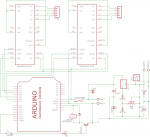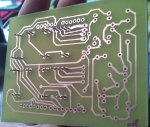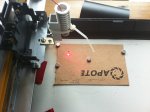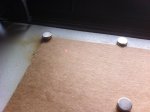- Joined
- Apr 23, 2013
- Messages
- 17
- Points
- 0
Hello folks !
I recently have completed my laser engraver with an dvd burner diode.
It runs at 300mV blabla.
But I have a problem with it. The driver is made by groover.
This is the schematic and the layout.
However I have some issues. And I guess it is because of the driver. I mean how I did it (solder/parts/replaceables etc)


C1 0,1uF
C2 47uF 25v electrolytic
D2 SA15A
IC1 LM317
R1 3,9 ohm
R3 51 ohm
R4 1 K ohm
R6 500 ohm TRIM POTENTIOMETER
D1 1N4148
R2 2,2 K ohm
T1 2N2222
VR05R051 RR1A - relay (digi-key = 306-1019-ND)
My remake




And this is how the problems looks

The problem is that the laser sometimes doesn't turn off as it should when it is moving to another engraving point. So it leaves an unwanted line on the working piece. When re-runnning it the errors occur at ((slighlty)) offset positions
I sometimes notice, that the laser turns off just in about the middle of the none-engraving move. Just like the relay gets the command much too late.
On the other hand it is sometimes really accurate with turning the laser off.
In my remake I switched the SA15A into an SA180A. This one is just tolerates 180V instead of 15V. Shouldn't be the problem.
Also C1 (the 0,1uF capacitor) is not as big as Groovers but it still tolerates up to 15V.
My guess was EMF interferences. So I tried to get all the cables for motors and the laser at an 90° angle to each other as good as it gets. This didn't fix it.
I replaced all the cables with shielded USB cables. Didn't help as well.
I got the advice to put another empty pcb or (isolated) metal sheet between the Arduino and the laser shield. Havn't tried this yet.
What do you guys think ?
I recently have completed my laser engraver with an dvd burner diode.
It runs at 300mV blabla.
But I have a problem with it. The driver is made by groover.
This is the schematic and the layout.
However I have some issues. And I guess it is because of the driver. I mean how I did it (solder/parts/replaceables etc)
C1 0,1uF
C2 47uF 25v electrolytic
D2 SA15A
IC1 LM317
R1 3,9 ohm
R3 51 ohm
R4 1 K ohm
R6 500 ohm TRIM POTENTIOMETER
D1 1N4148
R2 2,2 K ohm
T1 2N2222
VR05R051 RR1A - relay (digi-key = 306-1019-ND)
My remake
And this is how the problems looks
The problem is that the laser sometimes doesn't turn off as it should when it is moving to another engraving point. So it leaves an unwanted line on the working piece. When re-runnning it the errors occur at ((slighlty)) offset positions
I sometimes notice, that the laser turns off just in about the middle of the none-engraving move. Just like the relay gets the command much too late.
On the other hand it is sometimes really accurate with turning the laser off.
In my remake I switched the SA15A into an SA180A. This one is just tolerates 180V instead of 15V. Shouldn't be the problem.
Also C1 (the 0,1uF capacitor) is not as big as Groovers but it still tolerates up to 15V.
My guess was EMF interferences. So I tried to get all the cables for motors and the laser at an 90° angle to each other as good as it gets. This didn't fix it.
I replaced all the cables with shielded USB cables. Didn't help as well.
I got the advice to put another empty pcb or (isolated) metal sheet between the Arduino and the laser shield. Havn't tried this yet.
What do you guys think ?

















